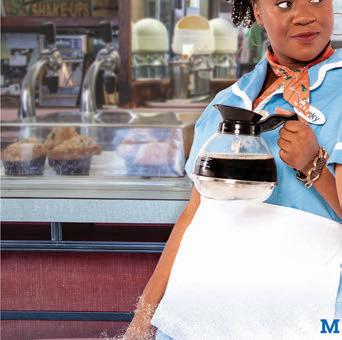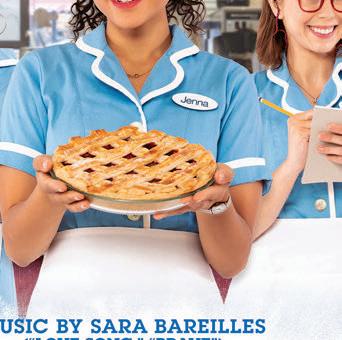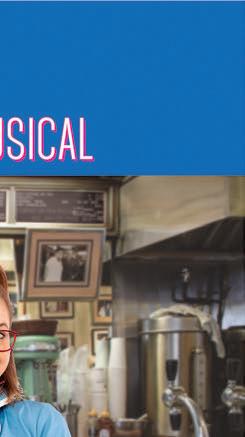










































BY JASON HARROD
In late2020, Victor Verazain, 46, was facing a lot of life challenges and stressors. His weight had climbed higher than it ever had before and he felt exhausted. A visit to his primary care physician revealed there was something more going on than weight gain. Routine blood work showed his ALT liver enzymes were well over 300, when the normal range is 7 to 56. A liver biopsy con rmed non-alcoholic fatty liver, the danger of liver disease and eventual liver failure. After getting those results and discussing what they meant with his physician, Victor knew he needed to make changes. He also knew he needed a medically sound plan to see the long-lasting results in his blood work that he needed in order to correct his health problems. It was more than the numbers on the scale, Victor explained, “What I needed was something more comprehensive, medically, that had the leverage of a true hospital.”
After researching various options, Victor decided on Hurley’s Celebrate Path to Success Medical Weight Loss program at the Hurley Bariatric Center. He decided this program, with a nonsurgical approach, was the right choice for him. It allowed him to work with a multidisciplinary team that could help address his concerns related to his liver health, diabetes and cholesterol levels while educating him about the lifestyle and nutritional changes he would need to make to achieve and sustain long-term health. Another bene t of the Hurley Bariatric Center was their seamless communication and collaboration with his primary and internal medicine physicians. “Hurley was able to work with my physicians, even though they were outside of the Hurley hospital network,” Victor said. is communication allowed for his monthly lab results to be shared as they were completed, so his doctors were updated in real time and could make informed
decisions about how to coordinate and optimize the various aspects of his treatment plan, such as diabetic medication and nutrition, as he made progress.
e Medical Weight Loss program at the Hurley Bariatric Center is designed to be a 12-week plan, customized to the medical needs of the individual, but it’s also meant to educate the patient so they can maintain their success beyond completion of the program. is approach extends to all of the various services o ered at the Center, which include di erent surgical and non-surgical options. Before surgery, the bariatric professionals help patients choose the right type of surgery for their situation. Following surgery, the sta continues to monitor progress while o ering support, such as nutrition and exercise counseling, to help patients have a sustainable weight loss outcome.
is ongoing approach is something that Victor values, even after nding rapid success. He began Hurley’s Medical Weight Loss Program in March 2021 and by June 2021, his lab results showed tremendous improvement in his liver enzyme levels and A1C, the measurement for diabetes. By September, he had healthy liver enzymes of 52 and a prediabetic A1C level. He had lost a signi cant amount of weight too; but for Victor, these lab results were the numbers that meant success and better health. Since June 2021, he’s received continued support from the team at Hurley Bariatric Center and his personal physicians continue to monitor his labs and progress. Beyond the numbers in his lab results, Victor has seen even more changes, as he no longer feels exhausted all the time and is able to use his renewed energy while playing with his children. ®
The Hurley Bariatric Center is located at 6140 Rashelle Dr., Flint 48507 and can be reached at 810.262.2330 or by going to hurleymc.com. The team also offers seminars that cover bariatric surgery and medical weight loss options. Sign up to attend a seminar, either online or in person, at:
hurleymc.com/services/bariatric-center/ attend-a-seminar/

Every February, we’re proud to have this platform for celebrating Black History Month. e many ways it can be observed include learning about noteworthy black gures and their contributions, and learning about your community’s black women in particular. With our feature highlighting the Genesee District Library’s 2022 Black History Month Honorees, we check both boxes. Read about these inspiring individuals who were selected by the Black History Month Brunch Advisory Committee to receive awards this year (p.8).
Also pro led in this issue are two men using their talents to give local kids access to life-enriching programs: Tauzzari Robinson, CEO of Boys & Girls Clubs of Greater Flint (p.12) and Chef Nate Brown who is reaching Flint youth through the D.R.E.A.M.S. program (p.14).
In more than one issue of MCM, we have shined a light on the dark, disturbing and serious problem of human tra cking in Flint. is month, we highlight an organization dedicated to helping survivors of this heinous crime to put their lives back together: James-Moorehouse, Inc. (p.18). Isn’t it strange how such good people and such bad people can exist in the same world?
When I talk about good people, our “My Day” subject most certainly belongs in that group. My friend Leslie Toldo, “ e Weather Lady” is a longtime meteorologist at Mid-Michigan NOW (and MCM columnist) –but she does so much more. She shared her story with us starting on p.20.
It’s been a while since we could do a special bridal section, for obvious reasons. “My Wedding” features lots of trends for this year and tips from local industry experts. It is estimated that a recordhigh 2.6 million weddings will take place in the U.S. this year – and people will be ready to celebrate! Check it out starting on p.48.
Finally, I want to thank our guest writer (former My City sta writer) Myron Manns, who o ers a tribute to his good friend Oaklin Mixon, a popular Flint entrepreneur who passed away just before Christmas. (See p.80.)
As I write this, winter has us snow-covered and in the deepfreeze ... curl up with your My City magazine and stay warm! anks for reading,


&
PUBLISHER & EDITOR IN CHIEF
Vince Lorraine
MANAGING EDITOR
Sherron Barden
ASSISTANT EDITOR / WRITER
Peter Hinterman
STAFF WRITER
Cheryl Dennison
FREELANCE WRITERS
Mark Spezia
CONTRIBUTING WRITERS
Erin Caudell
Dr. Christopher Douglas
Vera Hogan
Joel P. Lagore
Alexandria Nolan
Leslie Toldo
GRAPHIC DESIGNER
Brett LaCross
WEB DEVELOPER / GRAPHIC DESIGNER
Jonathan Boedecker
PHOTOGRAPHY
Katy Kildee
OPERATIONS
ACCOUNTING/CIRCULATION
Kim Davis
NEW BUSINESS DEVELOPMENT
Dan Garman
ACCOUNT EXECUTIVE
Terese Allen
5152 COMMERCE RD. FLINT, MI 48507 810.230.1783 - MYCITYMAG.COM
My City Magazine, 5152 Commerce Rd., Flint, MI 48507, phone 810.230.1783. To authors, photographers, and people featured in this publication: All materials, articles, reports and photographs in this publication are the property of My City Magazine and cannot be used without written permission. e opinions and conclusions recited herein are those of the respective authors and not of My City Magazine. My City Magazine is not responsible for returning unsolicited manuscripts, photographs or other materials. Every e ort will be made however, to return rejected manuscripts, etc., if they are accompanied by su cient rst-class postage, but the publisher will not be responsible for any loss of such material. Copyright© 2022. All rights reserved. | Printed in U.S.A.
























































COMPILED BY SHERRON BARDEN


ONFebruary 24, the Genesee District Library will recognize the 2022 Black History Month honorees with a virtual event that will air on ABC12. Created in 2002 by the Genesee District Library, this annual celebration of notable community servants highlights three inspiring individuals and one organization selected by the Black History Month Brunch Advisory Committee. The contributions of the following people will be recognized.




Award of Excellence RECIPIENTS



Cook-Hawkins is the executive director of Alternative Solutions Development, LLC., a total life transformation platform. She is a wife, mother, business owner, City of Flint Commissioner, community advocate and First Lady of Prince of Peace Missionary Baptist Church.
A certi ed Professional Life and Transformation Coach, Cook-Hawkins has over 12 years of experience enhancing the performance of her clients and organizations.
During the Flint Water Crisis, Cook-Hawkins’ church developed the Flint4000 program to assist senior citizens and the homebound population who didn’t have access to clean drinking water. She has hosted marches to end gun violence in Flint, women’s conferences to build up and encourage women, and worked to end the saturation of liquor stores in the city.

During the early stages of the COVID pandemic, she handmade over 5,000 masks to help the residents of Flint and went on to create her business, Fabrics of Faith, to help prevent the spread of COVID nationwide.












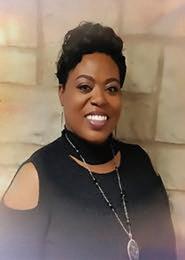
Danielle Green founded and directs the non-pro t organization, Empower, which works to improve the lives of youth and women through education, encouragement and exposure.
Serving on the Flint Community School Board and the Board of the YWCA of Greater Flint, she is also the author of the Hey Girl book series.
Green has received numerous awards for her work including the
Community Dedication Award, Phenomenal Woman Award, Top 25 Women in Business Award, Courageous Women Award and the Living Legend Award. She holds a general studies degree from Mott Community College, a Bachelor’s degree in Public Administration from Central Michigan University and a Master’s degree in Educational Leadership from Wayne State University.
A licensed clinical social worker, Horne serves as Director of Community Ministry at the First Presbyterian Church of Flint. She is also a counselor at the Gerholz Christian Counseling Center and has a private practice. In addition, she serves on the Board of Crossover Outreach and the McFarlan Charitable Trust.
Holding a Bachelor’s degree in Social Work from Saginaw Valley State University and a Master’s in Social Work from Eastern Michigan University, Horne is an inductee of the Greater Flint African American Sports Hall of Fame.
Horne is a member of Ebenezer Ministries and an honorary member of First Presbyterian Church of Flint.




Partner in Progress Award RECIPIENT


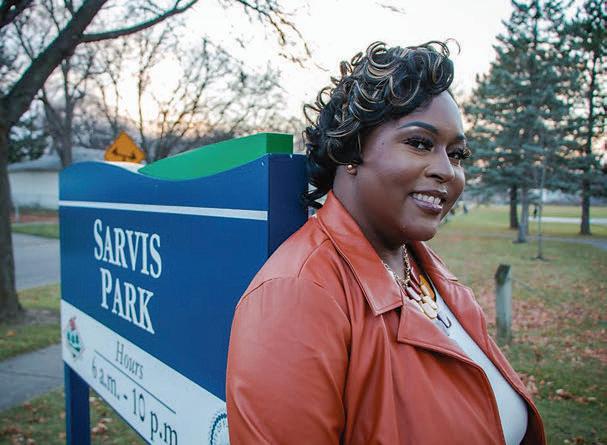
Founder, Sarvis Park Neighborhood Association
Founded and led by Dr. Ladel Lewis, the Sarvis Park Neighborhood Association (SPNA) works to champion the Sarvis Park community. ey have hosted several events, concerts, neighborhood cleanups and other activities over the last two years to help residents get to know each other and learn about resources available to them in the community.
In 2020, they created Sarvis Park Community Day as a collaborative
e ort with the SPNA. ey also pioneered the Caribbean Beats & Eats Festival at Sarvis Park.
In conjunction with Harambee Wellness, the SPNA started the Fitness in the Park program o ered from June to August. ey provided free professional photos in the park through NAG photography. In addition, they resurrected National Night Out in Flint in collaboration with Nation Outside, the City of Flint and the Michigan State Police.
Another Sarvis project is to bring more lighting to the Sarvis Park area. With a grant from Genesee County Habitat for

Humanity and in partnership with the Michigan State Police Light it Up program, free solar lights will be installed in the neighborhood as a crime prevention tool.
Dr. Lewis is a member of the Flint City Council and Zeta Phi Beta Sorority, Incorporated. In 2016, she coordinated pro-bono need assessments and water distribution e orts during the Flint Water Crisis. She partnered with Bottles for the Babies to create “ e Dos & Don’ts of Flint Water” and “Healthy Foods to Combat Lead.”
Dr. Lewis holds a Ph.D. from Western Michigan University. ®



Appointed executive director in 2014, Tauzzari Robinson has held various key roles with Boys & Girls Clubs of Greater Flint since 2009. Having been a Club member as a kid in Ohio, he credits that experience as having a significant impact on his life.
Robinson earned a Master’s in Public Administration with a concentration in nonprofit management at the University of Michigan-Flint and a B.A. in Psychology at the University of Toledo. He has received multiple awards for his exemplary community leadership, including the 2019 Herman Prescott Award - The Professional Association, BGCA. Most recently, he was honored with the 2021 Young Professional Leader Award by the Flint & Genesee Group.
Having been extremely busy helping the Greater Flint Club navigate through the pandemic and creating new ways to keep members engaged and provided for, Robinson graciously took a few moments to help My City readers get to know him better.
1. What was your very first job?
At 13, I was given the opportunity to work in the coat room at my local Boys & Girls Club in Ohio for $2 an hour. I pretty much sat in a room a little larger than a closet and made sure every kid’s coat and book bag was checked in. After that, more and more opportunities followed.
2. What advice would you have given your 17-year-old self?
Be open to new experiences. e people you will meet are going to shape you and mold who you’ll eventually become. I would also tell him that the next 22 years will go by really fast, so embrace the time that you have with your friends and family.
3. If you could only eat one meal for the rest of your life, what would it be?
Without a doubt, I could live the rest of my life on pizza. It is my absolute favorite food and I could eat it every day because it is so versatile. I was recently given a Gozney pizza oven and am trying to master the perfect pizza dough, so if anyone has tips …
4. What is one of your pet peeves?
I do not have much tolerance for bullies. I also hate tardiness.
5. What do you do to keep fit?
I try my absolute best to eat right. I also ride a peloton and just started dipping my toe into yoga over the last few months. Even though I have never liked running, I’m going to try to run one or two times a week when the weather gets better.





“I hope to not only continue serving youth and their families here in Flint and Genesee County, but also grow to serve more young people in unique ways. ”


6. If a toy company made an action figure of you, what two accessories would it come with?
Great question! ey would denitely be my iPhone and AirPods.
7. What is one work-related thing you hope to accomplish this year?
I hope to not only continue serving youth and their families
here in Flint and Genesee County, but also grow to serve more young people in unique ways. I am really proud of the new workforce development, mental health and wellness programs that we were able to add during the last two years of the pandemic. I know that there are so many families and kids who are not able to reach us at our two locations who could bene t from an organization
like the Boys & Girls Clubs. e best way to reach them is to meet them where they are, and that means more Clubs in more communities partnering with schools, churches, business owners, etc. Every $1 invested in Boys & Girls Clubs returns over $10 in future earnings and cost-savings to the community. Just imagine what we could do if we can continue to grow? ®






BY PETER HINTERMAN ® PHOTOGRAPHY BY KATY KILDEE


The rst time Nate Brown saw an African-American Chef was at 25 years of age. “I mean, that’s crazy, right?” he asked. “I was just ipping through the TV channels and I stopped at Chef G. Garvin’s show and this dude was cooking! And he had a pretty cool watch.” Brown went out and bought the ingredients needed to make the same meal and he got to work. It wasn’t the best, but it was a start. “For weeks after, I found myself thinking about cooking all day at work,” he laughs. en, Brown made a dish of his own and secretly put it on the table at a family open house. “I snuck it up there and then just sat back and watched.


Everybody was enjoying it, so I nally told them I was the one who made it. at’s when I decided to become a chef. at was it.” Brown studied culinary arts at Mott Community College before completing his education at e Art Institute of Michigan, graduating in 2010. Since then, Brown has been on an adventure that he never imagined possible. He’s developed his own business, owned a restaurant, had his own TV show, and has cooked for celebrities such as Kanye West, Halle Berry and others.
“I’ve had a great career,” he says. “I’ve done all the things.” His current “thing” has brought him back home, and although it may not seem as glamorous as his past pursuits, Brown considers it his most meaningful. “I’ve come full circle,” he says. “It’s my mission now to reach the younger generation and show as many


people as I can how to eat healthier.”
To accomplish this, he formed a partnership with Royce Stephens and his D.R.E.A.M.S. program. “Royce and I put a program together at Hamady High School to start an aquaponics garden that the students help to manage,” he says. “At the end of January, I started virtual classes to teach the kids how to cook the food grown in the garden.”






"I was a Flint kid whO had a dream that gOt me tO the tOp and giving back has always been a part Of me."

An aquaponics garden is a combination of plants and seafood, such as sh or shrimp. Fish that live in a tank underneath suspended plants eat and produce ammonia. Bacteria convert the ammonia to nutrients that are absorbed by the plants suspended above. e system produces nearly zero waste as it mirrors a natural ecosystem. In this way, students in the program learn about science, nature, nutrition and cooking skills. “Often, inner-city kids don’t learn about what good food can do for your health. One goal is to introduce them to the value of fresh food and to change their eating habits,” Brown explains. “Poor eating habits are often generational – if their parents eat unhealthy foods, they will too.” At a young age, Brown learned about the e ects of a poor diet. “As a teenager, I dealt with high blood pressure and needed medication to control it,” he says. “As I became more educated, I began to change my diet and became more active. At 37, I was o the medication.” During the past summer, D.R.E.A.M.S. started a pilot program












in which kids were delivered a box of ingredients for a meal and then, Brown taught them to cook it with a virtual lesson. It was a resounding success and both Stephens and Brown hope to have the same success this winter with the current program. As the cooking classes continue into the future, Brown hopes he can be a positive role model and mentor to the students in the way his school sports coaches were to him. “ e coaches helped save me,” he says. “Now, it’s my turn to take on that role. I had to wait until I was an adult to see an African American chef. I want these kids to see that cooking can be a profession for them.”
e D.R.E.A.M.S. program has been such a rewarding pursuit for Brown, he is looking to expand it and tie it in with some of his other professional plans. As soon as this spring, he will open his rst food truck with a business partner in Chicago, hoping to

have a food truck in at least ve cities including Detroit. And, he hopes to start an extension of D.R.E.A.M.S. in each city. “I want to help educate youth about food and being healthy anywhere I can,” he states. Looking even further into the future, Brown plans to open a new restaurant by 2024.

Chef Nate Brown has never stopped moving forward and has found new motivation in the city of his childhood. “I love this city. Flint molded me and prepared me to go out and be successful,” he says. “I was a Flint kid who had a dream that got me to the top and giving back has always been a part of me. I want to do my best for the community and plan to continue doing so. It’s very exciting!” ®













BY PETER HINTERMAN

heryl Golidy has a knack for identifying the needs of her community and helping the underserved. As a nurse and caregiver, her goals are always met with compassion, understanding and the drive to support those in need. So, when she attended a conference and training session on human tra cking in Detroit, the next step for her to take in life was revealed. “I had to learn more. I had so many questions,” she states. “I spoke to the head of the organization who gave the presentation and asked for more information. ey invited me to take part in their outreach program, learn how to identify those being tra cked and how to help them. I was with the program for six or seven months.” After her training, Golidy returned to Flint with a mission. “Human tra cking is a problem and a big problem in Flint,” she explains. “I’ve seen all kinds of things during training and as I ride down streets in Flint, I can spot the problem quickly.”



In 2019, Golidy founded James-Moorehouse, Inc., with the mission to care for and support women in recovery from tra cking, prostitution, addiction and homelessness. e organization is named after her family’s last name (James), the last name of a fellow volunteer and friend (Moore), and “house” as the future focal point of care. She quickly established a board of directors and joined Genesee County’s Human Tra cking Task Force. “We located a building in Downtown Flint that will serve as temporary housing for those in recovery,” she says. “After securing all of the paperwork necessary, we were getting people and funds in place for renovation when the pandemic hit and put everything on hold. Now that things look to be better, we are getting ready to begin renovations and hopefully open the building in the spring or mid-summer.”
With the project on hold during the pandemic, Golidy focused on creating relationships with local organizations, providing outreach to Flint’s needy and building awareness of the human tra cking problem. She has aided and built partnerships to further her endeavor with organizations such as St. Luke N.E.W. Life Center, the New McCree eatre and Mott Community College working with the Black Student Union to provide outreach to the area’s homeless and help raise awareness of human tra cking. “ e students have been very interested in learning about the problem and working to help,” she adds.



“

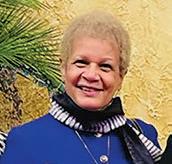


POSSIBLE”
Cheryl Golidy, Founder






JAMES-MOOREHOUSE, INC. HAS A PRESENCE AT THE FLINT FARMERS’ MARKET WHENEVER POSSIBLE TO SPEAK AND EDUCATE PEOPLE ABOUT THE HUMAN TRAFFICKING PROBLEM.
“During this time, we also visited warming centers and helped provide those who were there with goods and COVID-19 protection equipment.” Golidy cites Harris Memorial Church of God in Christ as providing integral support for her outreach activities. To spread awareness of human tra cking, James-Moorehouse, Inc., took part in Flint’s Juneteenth celebration last year and visited multiple parks and organizations throughout the city. James-Moorehouse, Inc., also has a presence at the Flint Farmers’ Market whenever possible to speak and educate its patrons.
As soon as the house opens this year, James-Moorehouse, Inc., will be in full swing. “We plan to provide 24 months of safe housing for survivors with full support and recovery programming,” informs Golidy. “We will work with other organizations such as the Flint Police Department to help as many as we can. e goal is to help survivors become self-su cient through healing, security, support and education.” Once the house is established, Golidy and volunteers will begin the Saved by Grace outreach program which identi es and o ers help to those in need on the streets of Flint. “It’s what I was taught as a volunteer in Detroit during training. We can provide a way out for those who may not think it’s possible,” adds Golidy.

James-Moorehouse, Inc. is about giving hope to those in the city who feel trapped in slavery, addiction and homelessness. It’s an organization of support and safety for those who feel alone and vulnerable. For Golidy, it’s something she feels called to do. “As soon as the house is up and running, I am dedicating all of my time to it,” she says. “I want to help alleviate the hate and su ering in the city and promote its happiness.”
All her life, Golidy has cared for other people and maintains that there is good in everyone. And, she believes that through her e orts and the compassion of others, James-Moorehouse Inc., will help survivors of human trafcking get back on their feet, stand up, and rise to glory.




If you would like to learn more about James-Moorehouse Inc., donate or volunteer, visit James-Moorehouse. com or email Cheryl Golidy at golidyc@gmail.com. ®





BY CHERYL DENNISON
Afamiliar face around Greater Flint, Lelsie
Toldo has been a meteorologist with Mid-Michigan NOW since May 2015. “I’ve been reporting the weather in mid-Michigan since 2004,” she says. She got her start reporting the weather in Casper, WY and worked in Detroit for seven
years, in Jackson, MS and at another mid-Michigan station for a total of 31 years in the eld of broadcasting.
Toldo lives in Linden with her husband Rick and their three dogs: Bear, Gus (Labrador Retrievers) and Lucy, a Golden Retriever. Toldo adopted Ellie, a black cat, from the Humane Society of Genesee County in 2020. “She’s our rst cat,” she says. “It was a whole new thing for us but she is the greatest!” Her path to becoming a meteorologist was not a typical one. She studied communications at the University
of Wyoming and ended up with an internship at a radio station. While working as an on-air deejay in Casper, WY a weather job became available and she was asked to apply for it. “I was completely ba ed! I went to the interview and got the job,” she remembers. “Back then, things like that happened.” When she began doing weather in Detroit, Toldo entered a three-year broadcast meteorology correspondence course through Mississippi State University. “I gured since I was reporting the weather, I’d better learn about it,”

she admits. Exams were given through the National Weather Service.
According to weather.gov, it takes a dedicated group of meteorologists to correctly interpret weather data, deliver accurate forecasts and warn us when dangerous weather threatens. National Weatherperson’s Day is celebrated on February 5 and commemorates the birth of John Je ries, a Boston physician and one of America’s rst weather observers. is is a day “to recognize and thank the men and women who collectively provide Americans with the
best weather, water and climate forecasts and warning services of any nation.”
Toldo chatted with MCM about her typical day on the job.
As the morning meteorologist at Mid-Michigan NOW, Toldo’s day begins in the wee hours of the morning. “I set my alarm for midnight but I wake up a little earlier. I like to ease into my day,” Toldo states. She does some spiritual readings and plays with the dogs and the cat. “I like to relax and not be all stressed out when my day begins.”
While most of us are sleeping, Toldo leaves her home in Linden and arrives at the station on Pierson Road in Flint.
“At around 2am, I look at my emails and the weather forecasts.
Between 3-3:30am (before hair and makeup) she does something that has garnered quite a number of followers – a Facebook Live video from the weather center. Toldo talks in a casual fashion about things going on in her life, music, her pets and also about the weather forecast for that day. “It’s nice and it’s fun,” she admits. “A lot of the same people watch the videos every day; I feel like I know them. I really try to interact with people as much as I can.” Toldo is also the medical reporter for Mid-Michigan NOW for the daily segment “Keeping You Healthy.” Most mornings, the producer will send her three to four health-related stories that could be of interest to viewers. She goes through the stories, writes up her report and edits it. “I tweak the story to t our show,” she says. “I take out the fancy words. e secret to good broadcasting is talking to people in a way they will understand. I’ve always had a laid-back style.”


4:30am
Toldo gets ready for the broadcast, puts on makeup and does her hair.
5am-9am
“We go live at 5am,” Toldo states. During the broadcast, the news anchor is the only other person in the studio. “ e cameras are all automated and operated by a computer in the control room. e producer talks to us through a device in our ear.” ey are live on the air for four hours – until 9am – two hours on NBC25 and two hours on FOX66. Her workday ends at 9am.
On occasion, Toldo anchors the broadcast of the program “Community Wide” which airs on CW46 at 11:30am on Sundays. She also reports, writes and edits videos for medical stories and does a segment called “Leslie’s Pet Project” twice a month. “I can’t imagine not reporting,” she says. “I love writing and I love storytelling.”


In her spare time, Toldo spends time with her husband and their pets. In the warmer months, she also enjoys running and kayaking. “I love doing things with my friends and I taught myself to sew and craft during the pandemic.”
Toldo is also well known throughout the community for her volunteerism. For more than seven years, she has taught classes at Genesys Hurley Cancer Institute. “ rough the Quality of Life Program, I’ve taught journaling, a grief class, spiritual growth and end-of-life planning,” she shares. “My students are all cancer patients and survivors and occasionally, caregivers. It’s been one of my most rewarding experiences.”
Toldo has been involved with the Humane Society of Genesee County for around 18 years, having
“I’m very passionate about trying to make a difference in people’s lives.”
served as a board of directors member and emcee for many of their annual fundraising events. And, she writes a popular monthly column titled “My Musings” for My City Magazine
Add to this list of commitments the time she spends helping people who are in recovery from an addiction. “I’m very passionate about trying to make a di erence in people’s lives,” she says. “It’s no joke. ere is an opioid crisis and a large number of overdose deaths in

our community. ese are people who are broken in a signi cant way.” Toldo also hosts events for the American Heart Association’s “American Heart Month” which is in February. e work of this organization has personal meaning for Toldo, as her mother died from a sudden heart attack four years ago at age 70. “I miss my mom every day,” she says.
One question followers of this popular news personality ask frequently is, “What time do you go to bed?” Toldo says she likes to get at least seven hours of sleep and usually goes to bed at 3pm, but watches TV for a while or reads to relax. She is usually asleep by 4-5pm. “As the medical reporter, I know that sleep is so important for our health. Most people do not get enough.”
LEFT: PRE-BROADCAST, TOLDO CONNECTS WITH FANS VIA FACEBOOK LIVE.
BELOW: TOLDO AND HER HUSBAND, RICK

e meteorologist says she is inspired by people in general. “I’m so lucky that I get to meet people from so many walks of life.” She is also inspired by her husband. “Rick o ers me so much love and encouragement. at is so important to my peace of mind. He keeps me grounded.” She nds the many volunteers who do so many great things for the community to be inspiring, as well.
Toldo very much enjoys her role as e Weather Lady. She has a great deal of respect and admiration for the people she works with at the station. “ e producer, directors and tech people are all amazing!” she exclaims. She also has high regard for Chief Meteorologist, Ahmad Bajjey. “I really admire him and his work ethic and I think he will go really far,” she says. “I learn a lot from my younger colleagues.”
Toldo also enjoys working with Morning Anchor, Mike Woolfolk. “Mike has a great sense of humor,” she says. “We laugh a lot in the morning, the whole crew. I’m really lucky!” ®

BY ERIN CAUDELL
I have never been a big “Valentine’s chocolate” person. Sometimes, a little something di erent – like a little lemon and raspberry – can be the secret to sweet romance. And, you can never go wrong with buttercream frosting. is recipe uses a fun ingredient: freeze-dried raspberries in the frosting (you can also use fresh) to give it the pink color. If any holiday calls for a little extravagance, it’s this one!
• 1.5 sticks unsalted butter, room temp
• 2 cups all-purpose our
• 1 teaspoon baking powder
• ½ teaspoon baking soda
• 1 teaspoon salt
• 2/3 cup whole milk
• 1 Tablespoon lemon zest
• 1/3 cup lemon juice
• 1 cup granulated sugar
• 2 teaspoons vanilla extract
• 2 large eggs, room temp
• 6oz cream cheese, room temp
• 6 Tablespoons unsalted butter, room temp
• 1 cup plus 2 Tablespoons confectioners’ sugar
• ¼oz. freeze-dried raspberries, nely ground
• 1 pint fresh raspberries

Erin Caudell is co-owner of The Local Grocer, a horticulturalist, herbalist and farmer.

• Preheat the oven to 350F. Butter and our the bottom and sides of a 9-inch round cake pan.
• Whisk together the our, butter, baking powder, soda and salt. In another bowl, stir milk and lemon juice. Using a mixer, beat the butter, lemon zest, granulated sugar and vanilla until light and u y, about 3-4 minutes. en add eggs, one at a time. Add our and combine, alternating with the milklemon mixture.
• Add batter to prepared pan and bake until golden, 40 minutes. Let cool.
• Beat cream cheese and butter until light and u y. Add confectioners’ sugar and freeze-dried berries.
• Frost cake and decorate with fresh berries.
Happy Valentine’s Day! ®



COMPILED BY SHERRON BARDEN
OnFebruary 12, the Flint Symphony Orchestra will continue the 2021-2022 season’s Classical Concert Series, “RENEWAL e Timeless Healing Power of Music Inspired by Nature.” e FSO and Maestro Enrique Diemecke will be joined by multi-award-winning Steinway Artist, Alessio Bax.



At the record age of 14, Alessio Bax graduated with top honors from the Niccolò Piccinni Conservatory in his hometown of Bari, Italy where his teacher was Angela Montemurro. He studied in France with Francois-Joël iollier and attended the Chigiana Academy in Siena, Italy under Joaquín Achúcarro.



In 1994, Bax moved to Dallas, TX to continue his studies with Achúcarro at Southern Methodist University’s Meadows School of the Arts. In 2009, he was awarded an Avery Fisher Career Grant and four years later, received both the Andrew Wolf Chamber Music Award and Lincoln Center’s 2013 Martin E. Segal
Bax is said to be without a doubt “among the most remarkable young pianists now before the public.”
GRAMOPHONE


Award for Emerging Artists. In fall 2019, Bax joined the piano faculty of Boston’s New England Conservatory. Combining exceptional lyricism and insight with consummate technique, Bax catapulted to prominence with First Prize wins at both the Leeds and Hamamatsu International Piano Competitions, and is now a familiar face on ve continents, not only as a recitalist and chamber musician, but also as a concerto soloist who has appeared with more than 100 orchestras, including the London, Royal and St. Petersburg Philharmonic Orchestras; the Boston, Dallas, Sydney and City of Birmingham Symphony
Orchestras; and the NHK Symphony in Japan, collaborating with such eminent conductors as Marin Alsop, Vladimir Ashkenazy, Sir Andrew Davis, Sir Simon Rattle, Yuri Temirkanov, and Jaap van Zweden.
Recent performance seasons have seen Bax make his solo recital debut at London’s Wigmore Hall, which aired live on BBC Radio 3, and give concerts at L.A.’s Disney Hall, Washington’s Kennedy Center and New York’s Carnegie Hall.

Beyond the concert hall, Bax is known for his longtime obsession with ne food; as a 2013 New York Times pro le noted, he is not only notorious for hosting “epic” multi-course dinner parties, but often spends intermissions dreaming of meals to come. ®

GRIEG Piano Concerto, op. 16, A Minor COPLAND Appalachian Spring: Suite February 12, 2022 7:30PM | The Whiting For tickets, call 810.237.7333. tickets.thewhiting.com/9027















BY PETER HINTERMAN ® PHOTOS PROVIDED BY REBECCA ZEISS
Inthe very beginning, Rebecca Zeiss tried her best NOT to be a photographer. Because of her last name (the Zeiss company has been a worldwide leader in photographic lenses since 1890), she wanted to make a personal impact with a di erent style or artform. She studied painting and drawing at the University of Michigan in Ann Arbor and took a photography class solely as a way to document and showcase her creations. at class, however, led to photography as a hobby and eventually a profession. In the end, she couldn’t escape it.
“I took the class for fun,” she remembers. “I wanted to photograph my work and thought it would be a good way to document my portfolio. It wasn’t meant to be my focus.” To make ends meet, she worked as a wedding photographer but realized that kind of work wasn’t for her. “Doing that made me hate my camera and I quit taking pictures for nearly ve years. I didn’t pick up my camera again until 2002,” she adds. It was then that she found inspiration and a way to blend the medium with her understanding of art and the world. She received her MFA in photography from
Central Michigan University and since 2005, has taught photography and printmaking at UM-Flint. Her work has been exhibited in private collections, museums and universities throughout the United States and internationally.
Inspired by shared individual stories, memories and dreams, her photography and subsequent collections are centered on objects and their storytellers. For example, “Aura Objecta” is a collection of images of her grandfather’s tools as they appear used and weathered from years of use, or appearing as well-cared-for and gleaming. Each tool holds

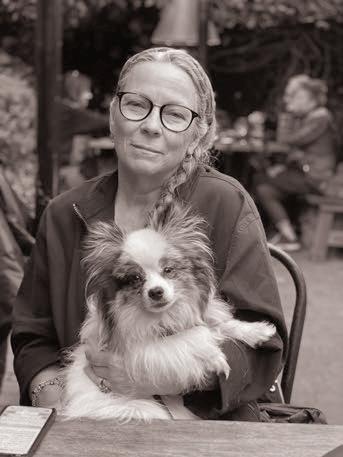
ABOVE: ZEISS AND FLASH, HER RESCUE DOG
LEFT: ONE OF ZEISS’ FAVORITE IMAGES AND ONE OF HER FIRST ATTEMPTS TO BRING SOMETHING SHE IMAGINED INTO REALITY.
BELOW: ANOTHER FAVORITE, THIS PHOTO ACTS AS A BRIDGE BETWEEN ONE EVENT AND THE NEXT. IT’S WHERE “BEFORE” MEETS “AFTER.”

profound energy and aura re ected in the life of her grandfather. In “Forgiveness,” Zeiss uses her own objects to portray her experience in a con ning relationship, and “Glimpses of Invented Dreams” captures objects that represent a participants’ shared dreams. e range of her works are printed on Japanese Kozo paper or developed with the collodion plate process.
Her most recent installation entitled “Seeking Solace” was exhibited through the month of December at Flint’s Buckham Gallery. In it, each picture acts as a doorway to a story – an image representing the hopes, dreams, loves and tragedies of each individual participant through the history of a chosen object. “Each subject is a volunteer who brought an item with them that holds an important story in their life,” explains Zeiss. “I listen to their stories while we go through the process of recording and creating their image.” It is in this way that Zeiss portrays the memories and impact of the time shared by all of us. In each black & white photo, an anonymous participant presents a personal object in a way that reflects their feelings toward the object.
Truly, her photography process itself is an art form. Zeiss uses a R.H. Phillips & Sons 8x10 large format camera equipped with a Petzval lens (the rst portrait objective lens in the history of
photography, developed in 1840) and an antiquated wet plate collodion process developed in 1851. She has worked on this project for seven years and only during the spring and summer months, as natural UV light is needed. To date, she has pictures of 50 subjects and their stories. Her long-term goal is to publish the images and their stories in a book. “I don’t really have a set number of subjects to record stories of,” she says. “I’ll know when to end it when the time comes. For now, I’m just getting ready for my next participants.”
e process of “Seeking Solace” is shared between Zeiss and her participants from beginning to end. ( e walk-through provided here is just a rudimentary description of it, as many chemicals and agents must be applied in sequence and each step must be completed in a very precise manner for a successful outcome.) To begin, the participant holds their selected item and sits patiently while the focus and design are set. Next, the two prepare the plate in the dark room, then back to the camera for capture. “Depending upon a number of factors, they will sit between two seconds to two minutes on average,” adds Zeiss. en, the plate is taken to the dark room and developed. Once the image is approved, the original is scanned and printed to photo paper, then coated with resin to




LEFT: ONE OF ZEISS’ FAVORITE PHOTOS FROM “SEEKING SOLACE.” IN THE SUBJECT’S STORY, THE HOUSE REPRESENTS ANXIETY ABOUT WHAT WILL HAPPEN TO US, OUR LIVES AND SECURITY AS THE WORLD MOVES FORWARD.
LEFT BELOW: A PIECE FROM THE “AURA OBJECTA” COLLECTION


“I li en to eir ories ile we go rough e process of recording and crea ng eir image.”
create the best reproduction of the original plate. e image capture process can take an hour to three hours on average, during which time the participant shares their story with Zeiss.
Although the parameters of the process are the same for all the images in this body of work, each is a unique representation of the storyteller expressed within a common theme as seen or not seen through the lens’ focus and depth. “One lesson I want my students to learn is to remember design. Pay attention to the focal point of the photo and avoid what I call “thing in the middle” syndrome,” Zeiss laughs. Zeiss will often have her students visit her home in Midland for lessons and to take part in her antiquated processes.
Through “Seeking Solace” and other past inspirations, Zeiss continues to create art through photography that reflects
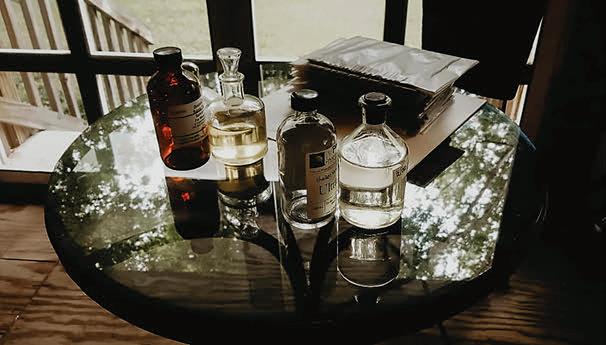

humanity’s collective unconscious and energy. Her photographs hold an air of both mystery and understanding as the viewer uncovers their own personal meaning. And, the beauty of it all is the realization that there is more to come.
“I am still looking for people to join the “Seeking Solace” project,” she says. “It will continue until it’s no longer challenging. Everyone has a story to tell.”
If you are interested in participating in Rebecca’s project, email Zeissphoto@ yahoo.com. To view examples of her work, visit Zeissworks.com. ®
















BY MARK SPEZIA
Amid the sounds of dribbling and squeaking sneakers, Keno Davis, rst-year coach of the second-year Flint United professional basketball team, outlined his vision for the program.
“Our biggest goals are giving these guys opportunities to move to the next level, put a great product on the court and give the Flint community another thing to rally around,” says Davis while keeping an eye on what was happening on the court during a third and nal team tryout at Insight Health and Fitness Center
in Flint last month. “I’ve always been a coach who has wanted to play a pro, uptempo style. I believe that’s not only the best way to win games, but it’s also what the fans like to watch and the way players like to play.”
Count Lance Adams among those players.
Although the nal roster of 15 was not set to be nalized until the rst week of February, the former International Academy of Flint standout is one of several area natives expected to return for a second season with the team which is part of e Basketball League.
“Last year was our building year and now, people really know who we are,” says Adams, an All-Region performer for Great Lakes Christian College in Lansing. “Everything is well-structured here and we did not always see that with other TBL teams we played last year. e sta is really on point with everything and we’ve seen guys get to the next level. It’s a good platform to better ourselves.”
Adams was referring to players like Jaire Grayer and Chris Barton.
Grayer, son of Flint basketball legend Je Grayer, was part of the Orlando
Magic’s 2021 NBA Summer League team and now plays for Orlando’s NBA G League squad in Lakeland, FL. Barton signed to play professionally in Finland. Adams hopes to be among those taking the next step, but joining Flint United has already changed his life for the better.
After racking up 1,178 points and drilling 295 threepoint eld goals at GLCC from 2016-19, Adams remained at the school the next season, serving as a student assistant for the basketball team before seeking a place to resume his playing career.
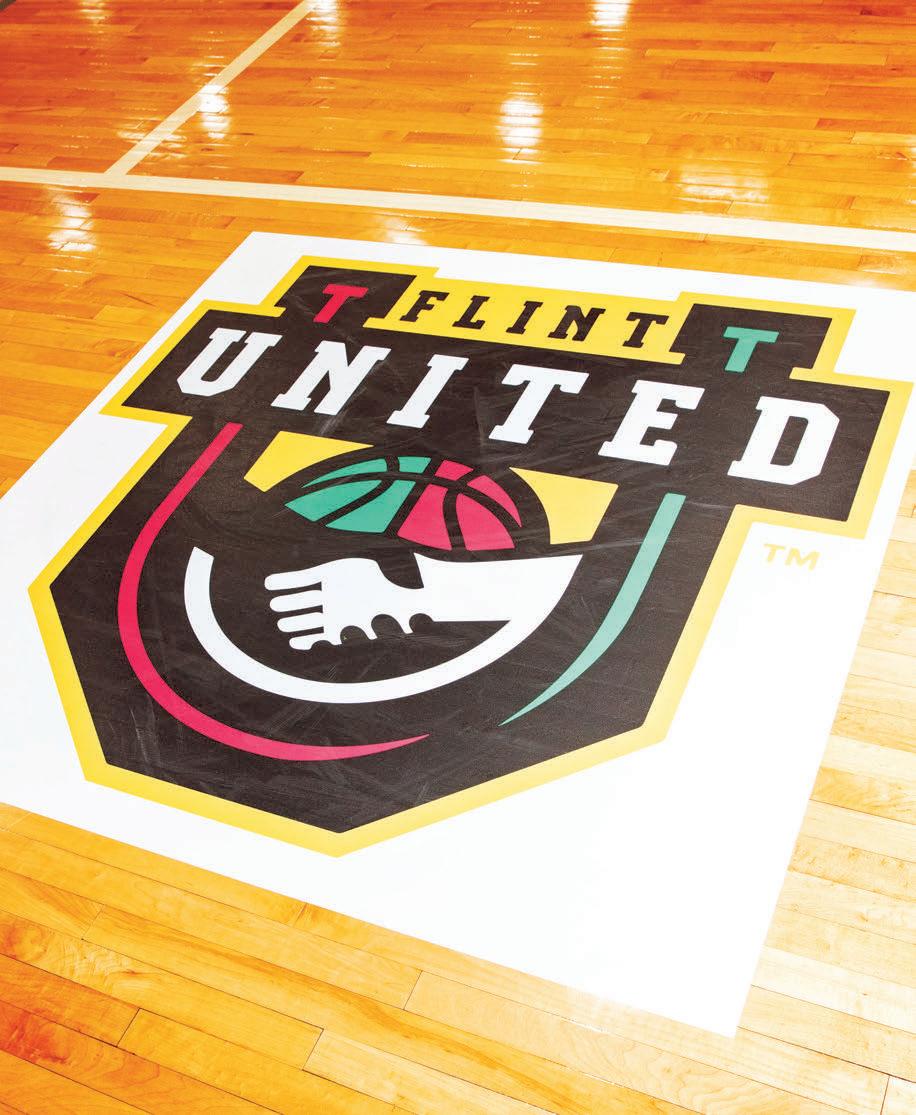




Hefound one, but it was 5,800 miles away in the former Soviet republic of Armenia.
While playing there and missing the important people in his life, including a young son, Adams received an Instagram message which lifted his spirits almost immediately. It was from a member of Flint United’s management team, asking if Adams would be interested in joining the team for its inaugural season.
“I didn’t even know Flint was going to have a new team, but I did some research and it looked like an organization I wanted to be a part of,” Adams says.
“It’s great to be home with my (three-year-old) son and close to family. Plus, I’m now working and coaching at International Academy. It’s a win-win situation.”
e situation has also been a win-win for Coach Davis, who was left pondering his next move after a nine-season run as Central Michigan University head coach ended last spring. When Flint United coach Charlie Bell stepped down last fall, team owner Kevin Mays, a state discus champion while attending Carman Ainsworth High School and a track All-American at CMU, reached out to Davis.

“I have stayed in touch with Kevin and other Central Michigan alumni, so he called me to gauge my interest in the job and it seemed like the right thing for me,” Davis says. “I could tell how excited Kevin is about the team and I was excited about the opportunity. I jumped right into it because the toughest thing for a coach is to not be coaching.”

Davis had coached in the college ranks every season but one beginning in 1991-92, including head coaching stints at Drake and Providence prior to joining the Chippewas.
He was introduced as the next Flint United coach in November 2021.
“I’m learning every day about coaching at this level, but, of course, I’ve always

“Our biggest goals are giving these guys opportunities to move to the next level, put a great product on the court and give the Flint community another thing to rally around.” Keno Davis

been a fan of the pro level and as a college coach, you are always trying to get your players opportunities at the next level and now I’m doing the same thing, personally,” he says. “I’ve been busy getting a sense of the type of players we will have through our tryouts and have been traveling to di erent areas, evaluating players who might be a good t for Flint United.”
Davis laid the foundation for becoming a college head coach under the guidance of legendary mentors like his father, Tom, current Auburn coach Bruce Pearl and Gary Garner, who won an NCAA Division II National Championship at Fort Hays State in Kansas.
Keno Davis began his coaching career with a four-season stint as a student assistant on his father’s sta at Iowa from 1991-95.
Over 32 seasons, Tom Davis was head coach of ve Division I teams -- Lafayette College, Boston College,

Stanford, Iowa and Drake. He nished with a 598355 record and ten NCAA Tournament appearances.
After graduating from the University of Iowa, Keno Davis spent two seasons (1995-97) under Pearl at Division II Southern Indiana. Pearl has since amassed a 385-193 record with Division I teams Wisconsin-Milwaukee, Tennessee and Auburn, including 11 NCAA Tournament berths.
From 1997-2003, Davis coached under Garner at Division II Southeast Missouri State before joining his father’s sta at Drake in the fall of 2003.






“I’ve

learned so many things from coaches I’ve worked under,” Davis says. “I’ve been fortunate to have such a strong coaching background – from the things my dad taught me to Bruce Pearl with his uptempo style and Gary Garner has been important, as well. From them, I learned very fundamental things about what it takes to implement di erent styles of basketball.”
Davis’ father retired from coaching in 2007, handed the reins of Drake’s program to his son and enjoyed a front row seat for Keno’s smashing head coaching debut.
Drake nished the 2007-08 season 28-5, including the program’s rst NCAA Tournament
berth since 1971. Davis was named national Coach of the Year by six organizations including the Associated Press and Sporting News. at success led to a three-season stint at Providence (2008-11) before he served as a Big Ten Network analyst during the 2011-12 season. Davis was hired by CMU in the spring of 2012.
His college head coaching record is 216-198, including three conference titles and six postseason appearances.


To have a coach of his caliber is huge for Flint United and the city.”
Adds Lance Adams: “You can tell coach Davis will build great relationships with the players and community. We’re really looking forward to playing for him.”
Encouraged by the talent level he’s seen at tryouts, Davis is really looking forward to assembling the second edition of Flint United.
“ e depth of this year’s team is going to be a strength and there is no doubt we’ll have 15 high-quality players,”
Kevin Mays, who also played football for CMU before graduating in 2012, is simply thankful Davis accepted his job o er. e two built a professional relationship when Mays served as Director of Fundraising and Development for CMU’s Chippewa Athletic Fund in 2015-16.
“Keno’s resume speaks for itself, especially once being named national Coach of the Year by so many media organizations,” Mays says. “He’s led highly successful programs on and o the court and provides great understanding and acumen of the game. Coach Davis knows how to identify, scout and develop talent.



he says. “ en, we’ll see who starts separating themselves to potentially be the next great talent coming out of Flint United. Overall, we want a team that spreads the court and
has versatile players at all positions whocan shoot three-pointers, but also attack o the dribble.”
Other than Adams, Flint-area natives Ja’Quin Jones, Reggie Reed and


Antonio Davis are also expected to return.
Jones, a former Carman-Ainsworth star and Adams’ teammate at GLCC, was a two-time All-American, nishing with 1,400
career points. Reed is a former Mount Morris standout.
Davis was elated to nally be playing basketball in his hometown again after joining Flint United. He previously played for Oak Park High School, Northwood University and the TBL’s Detroit Hustle.
“Coming Back To Play
For My Hometown Flint with Flint United!!,” Davis posted on Facebook prior to the start of last season. “All My Flint Fam Gonna Get A Chance To See Me.”
Davis poured in 25 points as Flint United edged his former team, 105-104, to conclude its rst season. However, that left the team with just a 6-17 nal record.
Adams is con dent of a better record this season which begins March 4 with a home game against Kokomo United at Dort Financial Center.
“ e brotherhood among teammates will be a big strength and the commitment of the guys is really strong,” he says. “We all want to come together and be a big part of something big.”
For more information or to purchase tickets, see flintunited.net. ®











BY PETER HINTERMAN
When the Civil War ended on April 9, 1865, the soldiers and members of the upper ranks slowly journeyed back to their homes and returned to normal daily routines. When they returned to Flint, the lumber and milling industry was booming and storefronts were opened up and down Saginaw Street selling wares from dry goods to textiles. With the addition of the railroad, Flint was becoming a destination for commerce. Near the end of the 1860s, the carriage business began booming with other companies joining the Randall Carriage Company (est. 1858) in the market, setting Flint on its path toward becoming “Vehicle City.” During this time, the mayors of the city were an odd mix of professionals and businessmen from lumber barons to doctors and war veterans. is series chronicles each of Flint’s mayors throughout history, providing a short account of their professions, lives and achievements made during their terms (if known). Some mayors were men/women of great deeds or of great controversy. Some simply acted as placeholders in time. Each one, however, chaired a city important to its country and its citizens on a path through triumph and heartbreak, and toward its eventual revitalization.
For Part 1 in this series, see the January 2022 issue of MCM!
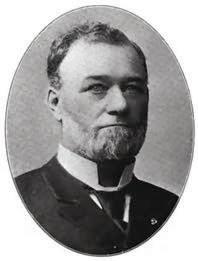
Born in Mt. Morris, NY William Barber McCreery moved to Genesee County, MI with his family in 1838. At the age of 22, he became a lawyer but his occupation was put on hold when a year later, he enlisted with the Union Army as sergeant with Company F, 21st Infantry. During his time with the Army, McCreery rose to the rank of Lieutenant Colonel and was injured a total of six times ghting in the battles of Williamsburg, VA and Chickamauga, GA where he was taken prisoner in 1862. Two years later, he escaped from Libby Prison in Virginia by way of a tunnel he dug with other prisoners. After nding his way back to Union forces, McCreery was forced to resign due to disability caused by wounds and neglect. Upon returning to Flint, he married Ada Birdsall from Fenton. He then started the law rm of Judd, McCreery and Avery, and owned a mill located on the Flint River. After his time as Mayor of Flint, McCreery became one of the directors of the Flint Water Works, director of the Chicago and North Eastern Railway, and the original stockholder of the Grand Trunk Railway. From 1871-74, he acted as U.S. Collector of Internal Revenue. He served as State Treasurer from 1874-78 and as the U.S. Consul to Valparaiso, Chile from 1890-93. After Ada’s death in 1884, he married Genevieve Decker from Flint. McCreery died in 1896 and was buried in Glenwood Cemetery.

Witherbee came to Flint with his parents in 1841. An industrious sort, he opened a self-named drug store (the now iconic Witherbee’s) as soon as he came of age. e store was a success, but Witherbee had an even more grandiose plan. In 1858, he opened e Exchange Bank, Flint’s rst legitimate banking institution, with partners Mr. Meigs and Mr. Stone. He managed the bank so well that in 1864, he bought out his partners and sold his drug store to Charles A. Mason. When the First National Bank was organized, Witherbee closed his bank and took the cashiership position with First National where he was content to nish out his time. He died in 1871 and was buried in Glenwood Cemetery.

Axford came to Michigan from New Jersey as an infant in the early 1830s. During his formative years, he lived in Detroit and attended the University of Michigan where he earned a degree in medicine. He then traveled to Philadelphia where he learned to be a surgeon. In 1858, he traveled to Flint and set up practice. He opened the Axford House (later known as the Kearsley House) as a joint hospital and residence. e hospital stood on the corner of Kearsley and Cli ord Streets for some time. (It was demolished during the construction of I-475.) Dr. Axford was well-known and well-respected by residents of Flint and elsewhere. He was perhaps the area’s leading gynecologist and an expert in the practice of ovariectomy (surgical removal of the ovaries). He was so liked that after his death, it was written in the Book of the Golden Jubilee of Flint: “So great was his success that many humorous tales were related of him, to the e ect that it was once said of him that there was not a home in town that he had not visited and that his fellow practitioners were all a bit resentful of his advent into their midst.” In 1873, Dr. Axford succumbed to a then-unknown disease and died at the age of 41. He was buried in Glenwood Cemetery.

Not much is known about this mayor of Flint except that he lived in the city and was a part of the lumber business in town and on the AuGres River near the Saginaw Bay. In Flint, Patrick found himself in a bit of trouble while hunting near a mill on the Flint River. As he was waiting for his prey, he heard rustling in the bushes before him and thinking he might have found a trophy, took the shot. As he pushed aside the twigs and leaves hiding his prey, he realized his mistake. Patrick had shot and killed a young native American. Upon hearing of the murder, the local Chippewa tribe was enraged and demanded vengeance. Patrick went into hiding and only emerged when all seemed convinced it was an accident. From that point on, Patrick spent the majority of his time at his lumber business to the north. ere, he made friends with the local tribes and even learned the Chippewa language. At the time of this death, he was known by the local tribes as “Good Bill.” It was during his time as mayor when the carriage industry began to ourish. William A. and A. B. Paterson and others started their carriage factories.

In 1836, Walker came to Flint and started work as a clerk at Beach & Wesson dry goods store, and then as a clerk at H. M. Henderson’s dry goods store. After a time, he went into business for himself operating a store at the corner of Saginaw and Kearsley streets from 1842-58 and engaging in the lumber business. In 1872, he and others opened the Genesee County Savings Bank. Walker’s most notable contribution to the city came from his work as treasurer and building commissioner for the Michigan School for the Deaf (MSD). Founded in 1848, the MSD was located in Flint and operated under one board along with the local asylum for the insane. In 1856, the two institutions were separated and, as trustees of the school, Michigan’s governor appointed Benjamin Pierson, John P. Leroy and Walker. Walker was a trustee until 1873 and because of his e orts, all of the larger and more expensive buildings of the school were built with the exception of Brown Hall. Walker died in 1877, four years after ending his time with MSD, and was buried in Sunset Hills Cemetery. During his time as mayor, Walker helped Flint begin to embrace the power of electricity as he organized the Flint Gas-Light Company with Josiah Begole, William Fenton and Jesse Atwood.
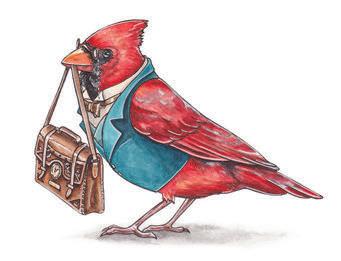
Born in 1817 in Sugar Grove, PA Fox came to Flint in 1856. While in PA, he engaged in multiple trades including farming, lumbering, rafting and manufacturing shingles. At 17, he went to New York to become a skilled tradesman and carpenter. Upon coming to Michigan with his wife Phebe, he rented a shop in Oakland County and began manufacturing steel-tooth cultivators. He soon moved north to Flint and opened a shop. In 1865, he started a lumber business (Walker & Begole) where he began manufacturing shingles for the growing city. After acquiring tracts of land in Lapeer County, the business of Begole, Fox & Co. became one of the biggest in the area. Fox then tried his hand at banking and helped to organize the First National Bank of Flint where he served as president. Using newly acquired capital, Fox helped to found the Flint Wagon Works where he sat as presiding o cer. During his two years as Mayor of Flint, the Flint Union Blues were organized and St. Paul’s Episcopal Church moved to its current location. Fox died in 1901 and was buried in Glenwood Cemetery. After his death, Flint Wagon Works continued operations for a decade until it was sold to Billy Durant in 1911 to become a part of Chevrolet.

Very few Flint mayors had an impact on both national and state levels as large as that of George H. Durand. Born in a small village in the Catskill Mountains of New York in 1838, Durand began his life as a farmer but as soon as 18 years of age, he left his family for the newer wilds of Michigan. Durand spent time teaching in Oxford, Oakland County, before meeting and studying law with William Fenton. He was admitted to the bar in 1857 and immediately opened a practice in Flint. He served on Flint’s Board of Education from 1862-67 and in 1874 was elected as a Democrat to the 44th U.S. Congress. In Congress, he served as chairman of the Committee on Commerce. In 1892, he was appointed one of Michigan’s presidential electors, as well as Justice of the Michigan Supreme Court. e next year, he was named president of the Michigan Bar Association and also appointed Special Assistant U.S. Attorney in the famous Chinese and opium smuggling case in Oregon. From 1893-96, Durand worked as prosecutor in opium smuggling cases along the Paci c, convicting nearly all defendants. ose on trial included a relative of a U.S. senator, a chairman of the central committee for politics, a customs collector in Portland, a special agent of the treasury department, and others. It was said during his national memorial that in the opium cases, Durand “scored one of the most signal and complete victories in the history of American courts.” Durand died in 1903 and was buried in Glenwood Cemetery. During his time as mayor, Durand oversaw the construction of Flint’s rst high school building. e city of Durand, MI is named in his memory.

Also one of the more recognizable names in Flint and Genesee County, Alexander McFarland (or McFarlan) was born in 1812 and came to Flint from New York in the early 1840s. In 1850, he started the lumber rm of Hazelton & McFarlan and purchased a mill. His mills burned a total of three times and each time, McFarlan built bigger and better. Soon, his mill and the one owned by Henry H. Crapo were the most successful in Genesee County. McFarlan began to purchase land and established a farm in Mt. Morris. ere, he employed a man named Charles W. Nash, who went on to become president of General Motors in 1915. In 1871, McFarlan became president and the leading stockholder of Citizen’s National Bank. His son-in-law, Robert J. Whaley – who made the initial loan to a young Billy Durant and his partner J. Dallas Dort in 1886 – would soon succeed him as president. McFarlan was also instrumental in developing Flint’s downtown. In 1871, he developed a subdivision south of McFarlan Street and a year later, nished the McFarlan and Co. North addition. In 1875, the city purchased a small tract of land which was made into its rst park. McFarlan gifted the park with an ornamental fountain and the park was named in his honor. McFarlan Park today sits on the point where Saginaw and Martin Luther King Avenue merge. During the end of McFarlan’s term as mayor, the Flint Journal was started by Charles Fellows and Washington Irving Beardsley. Alexander McFarlan died in 1881 and was buried in Glenwood Cemetery. ®


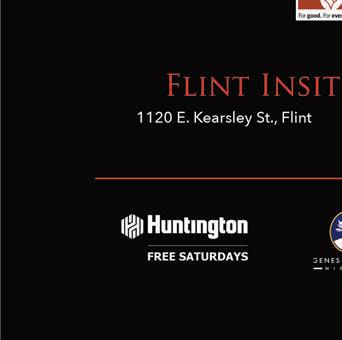




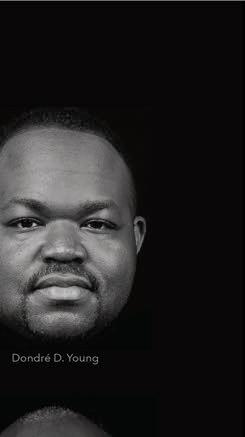










It is estimated that 2.6 million weddings will take place in the U.S. this year – a record high! e uncertain climate for social activity has inspired creativity and couples are exploring non-traditional concepts for their big day. Here are some trends for the wedding season ahead, and tips from local wedding experts.




















BY PETER HINTERMAN
So,you’ve been together for a while now. You’re in love and pretty sure the feeling is mutual. You know their bad habits and are ne with them (even the weird toenail-clipping one). You’ve met their family members and liked some of them. You are sure that you want to spend the rest of your life with this person and are ready to propose that you make it legal. How do you do it? Well, MCM has compiled a list of ve pro proposal moves to make sure it goes right. It’s time to get that big “Yes” MCM-style.
1. THEY SHOULD BE SURPRISED. e proposal should always be spontaneous for them, but not for you. Plan to do it in a natural setting or during an activity that isn’t too out of the ordinary. It can be fun to let their friends and family in on the scheme as long as they can be trusted. Don’t tell their best friend or even YOUR best friend if you think they’ll blab.
2. BE CHEESY. Oh, yes. It’s time to get romantic! Don’t be afraid to go a little over the top (within reason). Break out the rose petals, the candles, the ambiance. Maybe put on a little Barry Manilow or Barry White. (Well, Manilow could be a bit much; maybe save White for after the “yes” if you catch my drift.) It may feel a little ridiculous, but it will become a cherished memory.
3. DON’T HIDE THE RING. For gosh sakes, what are you doing? e ring was expensive – never let it out of your sight! Don’t put it in a shoe, a tree, a buried treasure chest, a package you mailed to your home

addressed to your partner with instructions to open immediately that got lost in the mail and when it did arrive was stolen by a porch pirate you had to hunt down leading to an epic adventure of mystery and suspense causing the destruction of two cars and a building and the addition of a new cat to your home (she said “yes”), and never hide the ring in food. e last thing you want is for your partner to spend the night choking and gasping for air.

4. TAKE A KNEE. Old-fashioned? Yes. Cliched? Of course. Totally sweet and endearing? Absolutely. Some customs should never be forgotten and this is one of them. You are asking another person to spend their life with you and only you. You are both vulnerable in the moment and surrendering yourself and all you stand for to them is eternally symbolic. Besides, their reaction when you take a knee will be forever priceless.
5. REHEARSE YOUR LINES. Know exactly what you will say and how to say it. You will be nervous, sweaty, shaking, stuttering, sweaty, scared, unsteady and sweaty. Practicing will help keep you calmer and more focused. Pro Tip: Keep it short and sweet. e more you want to say, the bigger the chance of stumbling.
With these tips, you will have yourself a beaming betrothed in no time. No doubt they will be overjoyed and impressed by how well you planned for and executed a question of such importance and are ready to start a life with you as a partner.
Good Luck and Godspeed from your friends at MCM! ®






















BY CHIP BELTINCK, JEWELER AND OWNER, SAWYER JEWELERS






Serving the community and surrounding counties for over 75 years, Sawyer Jewelers has seen many trends in ne jewelry come, go and return, especially with engagement rings and wedding bands.

Over the last decade, white gold has been the most desired for brides-to-be; however, a shift has occurred over the last two years. Rose gold, mostly forgotten about after World War II, has been revived as one of the newest trends with the current generation. But don’t count yellow gold out – it’s coming back hot!
While the traditional diamond engagement ring has little competition, colored precious gemstones have become popular. e most desired cut continues to be round, with oval cut a
close second, especially amongst the current generation, and pear-shaped coming in third. When considering lab-created or treated diamonds and colored gemstones, use caution. Just because it’s blue doesn’t mean it’s a sapphire.
When shopping for an engagement ring, we recommend nding a reputable, independent jeweler who can serve you for generations to come without sending your prized possessions o -site for repair. And remember: the key to a ring’s longevity is routine maintenance.
An engagement ring is a very personal item and should re ect your love and her style. Do not take what she desires lightly – it’s extremely important to her. A reputable jeweler can make any cut beautifully, so don’t shy away from the one that most represents her uniqueness. ®

BY JASMYN LEE, MARKETING MANAGER, THE LAUNDRY

Small event venues have been in high demand and 2022 will not be an exception. Opting for a “Micro Wedding” or “Minimony” allows for the ceremony to be an intimate a air that lets the happy couple spend quality time with the people they love most. And, they get to save money that would have been spent on a large-scale celebration. is choice of event format means crafting an experience that is very tailored to the couple’s preferences and creating an inviting space that feels like home. ere are many ways a planner can help make this happen with a small venue. Each branch of the planning process has a role in assuring the best experience possible.
One key element is to make sure that the venue has partnerships with local orists, custom bakers and rental companies to help the couple make the event space their own. Using purveyors such as Gerych’s Greenhouse, Flowers & Events, and Crust - a Baking Company allows for customization of details that make the day feel special and wonderfully delicious.
Another way a planner can tailor the event is to help the couple choose custom cocktails; this can vary by venue. Sometimes, it’s an original craft cocktail the venue o ers, such as e Laundry’s “Snappy Little Vodka Drink” or “ e Prisoner;” in other instances, it is a cocktail created by the couple.
An outstanding food menu makes the event feel like it was made speci cally for the special couple. is means ensuring that the venue’s food options will impress the wedding guests and that they will be thrilled by the avor of all the dishes.
e biggest factor is to choose a venue with outstanding service sta who are dedicated to making the day as perfect as possible. e sta should be ready to react to on-site requests on the y while delivering a truly seamless experience.
ere are many factors in choosing a small wedding venue, and each one should be carefully considered and planned. Cheers to every celebration! ®
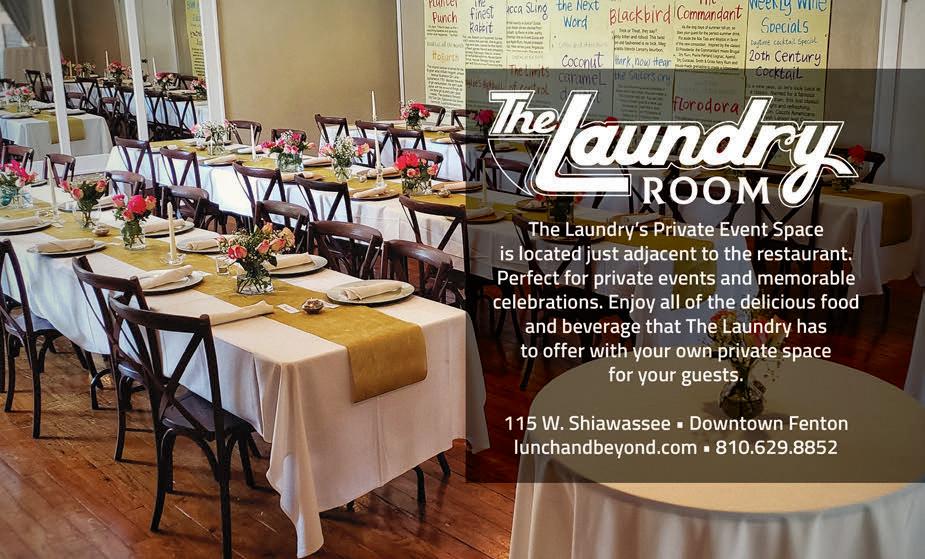

From bold details like voluminous sleeves and big bows to little black details and feminine oral prints, the 2022 runways highlighted inspired gown designs.




























Both modern and retro, many bridal collections featured big bows adorning backs, shoulders and waistlines.

























The return of strapless ball gowns creates a true princess moment.



Touches of black add a classically modern feel to this season’s designs, from a subtle bow or applique to a dramatic dipped skirt.








is season’s bridal fashions are generating excitement for brides-to-be who can nally say “I Do!” ®






BY MAEGAN PERRIN, FOUNDER/CO-OWNER NORAH’S BRIDAL






It’s2022 and brides will be making a statement in short wedding dresses. e “Little White Dress” is giving oorlength gowns a run for their money this year by o ering versatile options for the ceremony, second look and beyond.
e short wedding dress was extremely popular in the 1960s and has remained a frequent choice for civil ceremonies and today’s smaller weddings. is trend is here to stay for seasons to come, but with a larger presence beginning in 2022.

Over the past two years, COVID-19 has changed the way brides approach their Big Day. e uncertainty created by cancellations, postponements and downsizing of celebrations has led brides-to-be to choose fun over tradition when planning their wedding. Fortunately for brides, there is an LWD for everyone!
For brides who have their heart set on a oor-length gown, a short white dress is also a great option to wear for other wedding-related events such as the reception, rehearsal dinner, bridal shower, or even a second look. Another great perk of a short wedding dress is the opportunity to rewear it and show o those killer legs long after your wedding day.
From modern silhouettes to allover lace minis to sequin and beaded styles, there is a short wedding dress for every bride’s personality and venue choice. Paired with a statement veil, the look can rival any ballgown.
Whether you are eloping, having a micro-wedding or a casual-chic civil ceremony, designers across the world are debuting their best LWD styles, and they are to die for! ®






BY TRACY’S CREATIONS CUSTOM SPECIALTY ALTERATIONS
Years ago when she was teaching art education, Tracy (Ellis) Nuttle had a phrase displayed across her classroom desk: “ e de nition of creativity is taking things that already exist and recombining them in new and unique ways.” Now, her own creativity and decades of experience allow her to provide brides with something beautiful for their Big Day in new and unique ways.

“ e gowns frequently come straight from the salon when I customize and personalize them for the bride’s individual style,” she says, “but occasionally, I work with a previously worn gown that has been in storage.”
Nuttle enjoys a chance to repurpose a vintage wedding gown by modifying the style and creating a vision that re ects the present. “ is past year, I took a mother’s wedding gown and rearranged its classic 90s elements – the big pu ed sleeves, heavy applique with pearls and rainbow sequins and a larger ‘butt bow’ – into a current, classic restyle for her daughter,” Nuttle explains. e bride loved the gown’s original applique elements, so Nuttle incorporated them and created a new, sleeveless neckline with an open back and a modi ed rear bow. “We left the cutaway applique skirt untouched, highlighting the beauty of the gown her mother had loved a generation before,” Nuttle adds. “We created a new veil in the current style, as well. e best of both worlds, you might say!”
Nuttle created several “second generation” bridal fashions in 2021, designing for the daughters of brides she worked with 25+ years ago. “Seeing time progress in this way warmed my heart and reassured my con dence that my skills remain in demand and are appreciated after all this time,” Nuttle says. “I love what I do. I get to build, engineer, create, take apart and restyle a gown to order, AND play dress-up several times a week! I have the best job ever!” ®
BY JEROME RASKA, AIFD,AAF,PFCI, CF - BLUMZ BY JRDESIGNS

Ingeneral, weddings and other celebrations are very personal and should be re ective of the honorees. An event venue is selected based on a person’s likes and desires, and event designers typically use this as a guide when creating the event’s overall look and feel.
While we have designed many events in traditional settings such as banquet facilities and country clubs, we are also seeing unique and diverse venues such as barns and rustic or raw spaces. Couples are looking for something that expresses who they are.
Currently popular are oral themes that include many foliage types with accents of fresh owers incorporating several tints, tones and textures, as well as cream and blush-pink paired with shades of blue. Going forward, this year’s PANTONE Color of the Year “Very Peri” – will come into play. is warm and friendly blue hue opens up many possibilities for using natural products.
It’s all about the details! In addition to personal owers such as bouquets and wearables (corsages and boutonnieres), designers must create beautiful ceremony décor, as those spaces are the backdrop of many wedding photos.
When creating a look and feel for reception tables, rst impressions are very important. Using chargers or base plates can create visual impact upon guest arrival. Enhancing the overall feel using fresh owers combined with natural accents such as fresh citrus and veggies is a trend that is returning to the forefront.
Remember: owers and décor can completely transform an otherwise simple event space. We pride ourselves on listening to each couple’s needs and considering all of these factors when planning their Big Day! ®







COMPILED BY SHERRON BARDEN

there’s one thing that changed dramatically over the last two years, it was weddings! Pandemic restrictions led many couples to choose elopement, marry at city hall or in their backyards. While things continue inching toward normalcy in the wedding industry, typical huge and formal celebrations are still being put aside, for the most part. According to planners and vendors across the U.S., they have received record numbers of inquiries and bookings through 2024, thanks to COVID wedding postponements. e uncertain climate for social interaction has inspired creativity and couples are exploring non-traditional concepts – food truck parties, dance parties, open air tents, themes such as Old Hollywood, disco and lavish garden parties (thanks to “Bridgerton”) … all with a modern twist, personal touches and a focus on fun! Here are some trends for the wedding season ahead.

With so many couples having to change their plans in 2020 and 2021, this “step one” tradition made a pivot to digital format. e virtual save-the-date provides instant grati cation of getting responses right away. Not quite as romantic as the real thing, but it does save resources and cost (should the date need to be changed again) and can be followed by a traditional physical invitation that invitees can admire until the Big Day.





Pastel palettes have dominated decor themes for the past few years, so it’s time to invite bold pops of color to the party! Trends for this year include monochrome tones with vivid touches and o -beat, color-clashing combinations. Color trend forecaster PANTONE predicts the big colors for spring and summer 2022 will include pink-purple Orchid Bloom, vibrant Super Sonic blue, fresh Fair Green, playful Bubblegum pink, warm Coral Rose and cool Cascade blue. And their rich purple Color of the Year 2022 – Very Peri – is also right on trend.















While trends come and go, this tradition is the sweetest of all!



A reception decor theme that includes metallic touches can include the cake – from full metallic paint to light metallic owers and texture, this trend is growing.
For the couple who wants something unique, this design trend is a fun twist on a traditional cake. e dripping icing details can be found in a variety of designs, colors and avors. Some cake designers are combining two trends by creating cakes with metallic icing drips – well done!

A trend that promotes safety at a larger party and also makes guests feel more special, individual cakes can be placed at a seated dinner or sent home as a treat. (While they’re adorable, this can be a pricey option.)

1. TASTING IS A MUST.
Choosing the bakery to provide this special item is a big deal! Get a couple of references and set up a meeting so you can get to know their personality and make sure you “click.”
2. FINALIZE YOUR GUEST LIST (& VENUE SIZE) FIRST. You need to know how many people the cake will have to serve and what style will look best in the space.
3. CHOOSING A STYLE SHOULD BE ONE OF THE LAST TO-DO ITEMS.
Your favorite cake style simply may not “go” with the season, your attire, reception venue, decor theme, menu and owers. ese elements should be decided upon rst and will serve as a guide for the cake design.
4. THINK ABOUT DISPLAY.
Before you cut that beautiful cake, it will likely be on display at your reception. e shape of the cake is key to choosing a table that will allow the best presentation. A round table is perfect for round cakes, etc. Your orist can help with decorating the table to complement the theme.
5. ALWAYS CONSIDER THE WEATHER.
Getting married in August? Avoid a cake covered in whipped cream, meringue or buttercream: ey don’t stand up to heat. Ask your baker about summer-friendly icing options; you might want to go for a fondant-covered cake – it doesn’t even need refrigeration.


















is is a big trend: bright, edible owers will garnish cocktails, cakes, salads and hors d’oeuvres.
TO-GO

ink ice cream, donuts, cupcakes, etc. – a great way to personalize the party.


Both fun and practical –combine party favors with late night snacks. Pack bags with light, to-go meals for people to grab as they leave at the end of the big night.
Satellite & Specialty Bars • Cotton Candy Station
Ferris Wheel • Arcade Games • Tarot Card Reader
Oversized bu ets • Fast-food style items • Mini-food







BY VERA HOGAN

There is a saying, “all things happen for a reason.” I rmly believe this is true. For the past nearly two years, I have had a medical condition that rendered me unable to go out and about without the assistance of a cane or walker.
ankfully, my issue was temporary, and I am well on my way to full mobility. Not everyone is as fortunate, however, and I would like to share what I’ve learned – things most able-bodied people never give a second thought.
First: handicapped parking. I will be the rst to admit that I have used these parking spots, (just for a minute) when I wasn’t handicapped. I had no idea what a hardship this could be for someone with mobility problems. It sometimes means risking a parking spot further away or just skipping the store or restaurant altogether and going back home. e person who parked in that spot won’t even know what an inconvenience they caused for a fellow human being. en, there are uneven and badly cracked sidewalks. Someone using a walker must always keep their eyes on the ground to avoid pitching over the walker into
a nasty headlong fall. e same is true for a door jam that is even slightly raised, and they are everywhere.
Unless it’s a medical facility or government o ce, the entrance doors of most restaurants and some stores (without automatic doors) are extremely heavy and when you have hands on a walker at the same time, it is di cult to pull the door open and then get around it to go inside. e same is true for public restrooms.
Shopping locally is promoted all the time and while folks who get around with a walker would love to, it is nearly impossible to maneuver around most smaller stores. e aisles are very tight. I understand the need to maximize space with as much product as possible, but it makes looking for items without knocking everything over extremely hard. Perhaps one or two employees could o er assistance to the occasional handicapped shopper. Having a place to sit for a couple of minutes also would inspire a big sigh of relief and give the shopper another chance to spend more money.
ere are many more examples of this struggle; but in summary, when one has mobility issues, there are far more things to consider when going out besides what to wear. ings like: does the destination have nearby handicap parking? Even if it does, is the building entrance nearby? Are the sidewalks cleared of snow and ice? Will it be necessary to go uphill or downhill, even slightly? Are there stairs? Is there an elevator? Are the restrooms nearby? How long will I have to wait if I must stand? Is the excursion worth the e ort?
So, to the public – please have a heart and o er assistance when you see a handicapped person approaching and teach your children to do the same. ey will be incredibly grateful if you do. Believe me … I know! ®
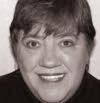
Recently retired, Vera Hogan is a 20year veteran of the newspaper business, having served both Fenton and Flint area publications. During those years, she was a reporter, associate editor, editor, web content editor and columnist. Her
popular columns have earned her multiple state awards. She resides in the City of Fenton. Email verahogan@hotmail.com.

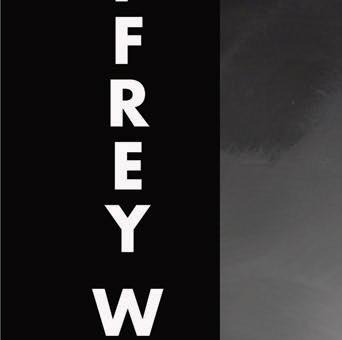












BY LESLIE TOLDO


February 16th rolls around and someone randomly does something nice for you, the news may not be all good.
February 16th is “Do a Grouch a Favor Day.”
Sure, it could just be a coincidence, but it begs the question: Are you a grouch?
If those traits seem to t your personality and you are also showing signs of depression, you may consider getting some help. erapy may help you work through negative feelings you have about yourself.

If you are just a garden variety complainer, the good news is that there are things you can do to change. Multiple websites suggest getting more exercise and sleep, as well as eating better. Isn’t that the advice for pretty much everything that ails us? It is; but these things can all help boost your mood, which probably needs an adjustment if you are only able to see the negative side of life.
One tip I found to help put the brakes on habitual complaining really seemed to stick out, however. When you catch yourself complaining, whether it’s about yourself or something else, try nding a little gratitude. Just make a list – it doesn’t have to be long – of things you are grateful for. is simple exercise will remind you that things really are not that bad, after all.
Before you answer, I should tell you that grouches are often the last to know that they are, well, grouchy. Merriam Webster says, “A grouch is a habitually irritable or complaining person: GRUMBLER.” e really bad news is, you may be an irritable, complaining grouch without even knowing it.
Just Google “are you a complainer?” A list of quizzes will pop up in the results. ere are lists of warning signs, too.


Sure, the most obvious sign that you’re a complainer is that you complain a lot. at’s only part of the equation. e other warning signs, which turned up on multiple websites, include being overly self-critical, unable to accept compliments, a perfectionist, struggling with criticism, comparing yourself to others and living in the past, focusing on “what-if.” at list of symptoms says something very important about grouches – they are generally unhappy with themselves. e truth is, people who do not like themselves typically do not seem to like much about anyone or anything else. Makes sense, right?


Another suggestion: if you are feeling a little grouchy, doing something nice for someone else can boost your mood and make you feel good about yourself.
Conveniently, if someone did single you out with a good deed on “Do Something Nice for a Grouch Day,” you can easily pay it forward. e entire week of February 17th is devoted to “Random Acts of Kindness.” You can do nice things for a slew of people without even telling them, if you would kind of like to hold on to your grouch persona.
When you are creating a list of people to randomly do kind things for, remember your fellow grouches. Remember that they are the ones who need those kind deeds even more than most. ®



An Emmy-nominated anchor/meteorologist/reporter at FOX66 and NBC25, Leslie Toldo has worked in TV news for over 30 years, nearly 20 in Flint. She is a blogger, writer, wedding and funeral officiant. Born and raised in Baton Rouge, LA, she graduated from the University of Wyoming. An avid kayaker, boater and runner, Leslie lives in Linden with her husband, Ellie the cat and three dogs: Bear, Gus and Lucy.









BY JONATHAN BOEDECKER
Recently on social media, people have been taking part in the ten-year photo challenge. is got me on a nostalgia kick and made me think of great movies that were released a decade ago. As I dove into the list of movies from 2012, I found a lot of hits. Now, of course there were blockbusters, but I focused on the movies that may have snuck past you while distracted – the ones you may have missed.
Here are my top picks to re-watch from 2012.


who believes that he has built a time machine. e closer they become and the more they understand about each other, the less clear it becomes whether Kenneth is just crazy or if he actually will successfully travel back in time.
“Silver Linings Playbook”
Always look for the good in everything.


“Robot & Frank”
A former jewel thief with dementia, Frank receives a gift from his son: a robot programmed to take care of his every need.
Frank’s son Hunter, an attorney with a family of his own, does not want to put his father into full-time care, so he buys a robot companion programmed to provide him with therapeutic care and help him carry out a xed daily routine while engaging in cognition-enhancing activities like gardening. At rst, Frank doesn’t like the robot’s presence in his life, but as he grows fond of Robot, he realizes that Robot is not programmed to distinguish between legal recreational activities and criminal ones, and can assist him with a not-so-legal adventure.



“Safety Not Guaranteed”
“WANTED: Somebody to go back in time with me. is is not a joke.
P.O. Box 91 Ocean View, WA 99393. You’ll get paid after we get back. Must bring your own weapons. I have only done this once before. SAFETY NOT GUARANTEED.”
ree magazine employees take on an assignment to interview a guy who placed a classi ed advertisement seeking a companion for time travel. A young intern, Darius, jumps at the chance to investigate. Along with fellow employees, Je and Arnau, she takes a road trip to a coastal town. While Je and Arnau waste time with personal pursuits, Darius spends time with Kenneth, a man

Pat, after losing his job and wife and spending time in a mental institution, winds up living with his parents again. And, all he wants is to rebuild his life and reunite with his wife, but a restraining order does not allow him to communicate with her. Meanwhile, his parents would be happy if he just shared their obsession with the Philadelphia Eagles and their bookkeeping operation. As Pat looks for a way to connect with his ex, including visiting their old mutual friends for dinner, he meets Ti any, who o ers to help him send messages to his ex-wife; that is, if he will do something very important for her in exchange.

“The Perks of Being a Wallflower”
Socially awkward teen, Charlie, is a wall ower – always watching life from the sidelines. at all changes when he starts high school and Sam and her stepbrother Patrick, two charismatic senior students, become his guides for the freshman year. With them, Charlie discovers the joys of friendship, rst love, second love, music, drugs and more. Charlie’s English teacher guides him toward his goal of becoming a writer and his new friends support his dream. However, we often make mistakes in life, and sometimes those mistakes can haunt us for a long time causing other complications. So, as his new friends prepare to leave for college, Charlie’s inner sadness from his past threatens to shatter his newfound con dence. ®


The Best of the Rest from 2012
“Best Man Down” “Chronicle” “Darling Companion” “Mud”
“Ruby Sparks” “Wanderlust”
“Wolf Children”







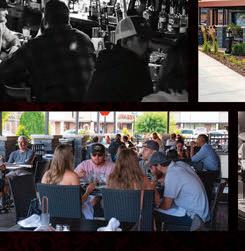






BY DR. CHRISTOPHER DOUGLAS
Labor market shortages do not appear to be improving and in fact, might be getting worse. Labor force participation, de ned as the percentage of the population either working or actively looking for work, is at a 44-year low. Only half of the decline in labor force participation experienced during the 2020 shutdown has been recovered. e labor market situation appeared to be deteriorating at the end of 2021, as well as into 2022.
In a normal economy, approximately 2% of the labor force leaves a job in a given month. is quit rate has increased past this level every month since July 2020. A record 3% of the labor force quit their jobs in November 2021 after a record 3% quit in September. Food service and hotel workers had the highest quit rates in December, when nearly 7% of workers in these industries left their jobs, which is stunning. Over 4% of workers in the retail sector quit in December, as well.
It is not surprising that these are the sectors in which the most workers are quit. Working in these service sectors was grueling before the pandemic and only more so after. Sta s are short-handed, which is leading to employee burnout. Many employers mandate their workers wear masks, even though the customers don’t. It’s not hard to imagine how hard it would be to wear a mask while working in these jobs, as well as dehumanizing. We have all seen the photos of people eating in restaurants or attending events unmasked while the sta is masked. We’ve also seen viral videos of customers screaming at workers because of higher prices or some government-mandated restriction a worker is required to enforce. It is unsurprising that quits are surging in these sectors and consumers should expect the retail experience to further deteriorate.

e childcare industry presents another issue. ere are 90,000 fewer childcare workers in the U.S. than before the pandemic, further pushing up prices of an already expensive service. Parents must plan for schools to suddenly announce that they are “going virtual” (as it happened in Genesee County early in January), or that a child’s bus won’t be coming that morning due to a driver shortage, something that has also routinely happened. Schools going virtual and bus routes not running result in parents having to scramble to nd childcare in a childcare industry that is severely short of workers. Many parents run the numbers and realize that working is not worth these hassles. is is especially true with 40-year high in ation eroding the purchasing power of wages.
Labor market shortages will not be resolved until all COVID restrictions are lifted, schools stay open permanently and life returns to normal. One would have hoped this would happen with the vaccine; the fact that it hasn’t is shocking. COVID fatalities are not increasing despite cases spiking due to Omicron, giving evidence that the vaccine is working. Life needs to return to normal. e current situation is simply not sustainable. ®

Dr. Christopher Douglas came to the University of Michigan-Flint in 2006. He earned a B.S. in Electrical Engineering and a B.S. in Economics from Michigan Technological University in 2001, and his Ph.D. in Economics from Michigan State University in 2007. As Associate Professor and Chair of the Department of Economics, he teaches Principles of Microeconomics, Principles of Macroeconomics, International Economics, Public Finance, and Sports Economics.

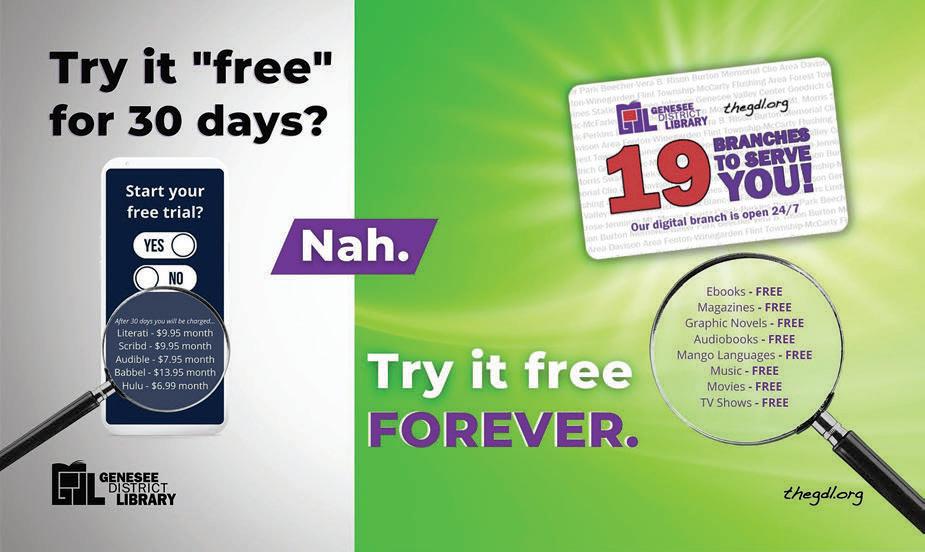


BY JOEL P. LAGORE, CFP®, AIF®
The wave of infections from the COVID Omicron variant that started just before the holiday break has been nothing short of breathtaking. I don’t know about you, but it seems like almost everyone I talk to lately has been infected and or re-infected. Vaccinated, unvaccinated – it seems like Omicron doesn’t play favorites and is out in full force to wreak havoc on our nation. e only good I can make of it is that (at this writing) it seems to be much less lethal than the previous strains.




Last month, I wrote about the research article by J.P. Morgan Chase which said they thought the new variant could nally get us to herd immunity and that this could mark the beginning of the pandemic’s end. Well, I sure hope that they are right, and with the amount of money and stimulus being pumped into the economy, we are very hopeful that we could be looking at a solid “stimulus driven” economic recovery.

in order to put the proceeds into crypto currency (which could be risky, as cryptocurrencies are subject to volatility and there is no Self-Regulatory Organization that oversees cryptocurrencies). is go-round, the bad debt isn’t on individuals; the massive debt that is piling up is being brought to us by our legislators. As of January 10, ‘22 usdebtclock.org said the U.S. had $29.4 trillion in accounted for government debt. e last comparison I have to the Roaring 1920s and the possibility of a”Roaring 2020s” is that back then, there was an illegal substance that people were desperately trying to get legalized so they could (legally) make money selling it: alcohol, which was nally legalized in 1933. Americans are now desperately trying to federally legalize marijuana, so that the business savvy can pro t from its sale and the government can generate revenue by taxing it.

representatives
With so many similarities between the 1920s and our current 2020s situation, it will be very interesting to see how this all gets resolved. During the next 4-7 years. I would not be surprised to see us enter into a huge, stimulus-induced economic boom in which things become desperately overpriced.
Truth and time tells all, and I am very hopeful that the Roaring 20s of the 2000s doesn’t end in the same fashion that the 1920s did. Until then, I can’t wait for the U.S. to be rid of this COVID stu , so we can start to sing “Happy Days Are Here Again”… like they did when they repealed Prohibition! ®

er securities through AE Financial Services, LLC (AEFS), member FINRA/SIPC. Investment advisory services o ered through OLV Investment Group, a Registered Investment Adviser. Insurance o ered through OLV Investment Group. OLV Investment Group is independent of AEFS. 1961359 01/22 is content is provided for informational purposes only and is not intended to serve as the basis for nancial decisions. OLV Investment Group is an independent nancial services rm helping individuals create retirement strategies using a variety of investment and insurance products to custom suit their needs and objectives. Neither OLV Investment Group nor advisors providing investment advisory services through OLV Investment Group recommend or facilitate the buying or selling of cryptocurrencies.
It’s often said that “history repeats itself.” I am one to contend that history often rhymes with the future. When we re ect on U.S. history, we need only look back about 100 years to see that we very well could be at the start of the next Roaring 20s. ere are multiple similarities that are simply uncanny. e rst similarity is one that we can’t ignore. In 1918, there was a worldwide pandemic labeled the “Spanish Flu.” We are now living through another pandemic. e second similarity is that the world back then was experimenting with a new and fun, unregulated way of doing business that allowed “regular” folks to own shares of large corporations; it was called the stock market. We now are engaging in another new, fun and unregulated technology and way of doing business called Bitcoin. e third rhyming reason of similarity: there was a ton of debt being used to stimulate the economy. e term “bet the farm” came from the Roaring 20s, when people would take loans out against their farms and invest it in (bet on) the new, ever-growing stock market. I’ve known multiple people who have sold their homes 800.338.4586

Durant 607 E. 2nd Ave., Suite 100 Flint, MI 48502 jlagore@olvinvest.com
Joel P. LaGore, Certified Financial Planner and partner with OLV Investment Group, focuses on money management. Joining the Downtown Flint revitalization effort, his office is located in The Durant at 607 E. Second Ave., Suite 100. Joel and his wife Sonya are raising two daughters in Flushing, where he enjoys philanthropic pursuits in his local community, in Flint at large and in Genesee County.












BY CHERYL DENNISON



Ihave been collecting cookbooks for many years and I love to read them. My very rst cookbook was Betty Crocker’s New and Revised Edition – a wedding gift I received in 1974. It was a good gift for me because when I got married, I did NOT know how to cook! is particular book is now worn and tattered, the pages food-stained and yellowed. I still prepare delicious meals today that I learned how to make from Betty Crocker’s book. I love to go second-hand shopping and have found many of my favorite cookbooks at used book stores and even at Goodwill. I especially like cookbooks that are put together by organizations, clubs and schools. One of my favorites is a book of recipes compiled by an elementary school booster club. e recipes are always family favorites that have been made with love for generations.
Another favorite is a book of recipes collected by the Potters’ Guild of Baltimore, given to me by my mother. In this book, I discovered many seafood recipes that, as I make them, take me back to my childhood days growing up in Maryland where seafood is plentiful.



and memories from Dorothy and her family. She personally signed it for me and wrote a message: “To my friend Cheryl, dinner is better when we eat together.”


Valentine’s Day is just around the corner and it’s time to think about how to celebrate the occasion with your sweetheart. And in my opinion, there is no better way than to prepare a romantic dinner for two. I have found many recipes in my collection that are perfect to make on Cupid’s Day. One of my favorites is Lobster Newberg, made from a recipe I found in another one of my beloved cookbooks, American Classics – which I purchased at a second-hand store in Fenton. It is not only lled with classic recipes, it also has a story to go along with each dish and beautiful illustrations. According to Christopher Kimball, editor and founder, American Classics helps you “get reacquainted with old favorites that you can fall in love with all over again.”
Of course, you can’t celebrate Valentine’s Day without chocolate! I love to make the German Chocolate Cake with Coconut-Pecan Frosting from the recipe in Betty Crocker’s cookbook (on page 233).
When I was doing a story about the famous Zehnder’s of Frankenmuth, I had the opportunity to speak with Dorothy Zehnder, the matriarch and heart of the place that is renowned for its fried chicken dinners. Dorothy gave me a copy of what was at the time her latest cookbook: From My Kitchen to Yours. e book is lled with timeless recipes
Cooking a meal from your favorite recipes is just one way to express to your loved ones how much they mean to you. But there is another recipe I try to use each and every day and that is a Recipe for Life: One large smile, lots of hugs, a jar of kisses, a big spoonful of kindness – topped with more hugs. is is probably the best recipe of all! ®

“Wrong River”
Flint Repertory Theatre
2.4-20.2022
Flint Firebirds vs. Kitchener Rangers
Dort Financial Center
2.9.2022
Colin Mochrie & Brad Sherwood
The Capitol Theatre 2.11.2022


Back to the Bricks® Presents: Chrome & Ice™
Dort Financial Center
2.11-13.2022
FSO Presents: Grieg’s Piano Concerto The Whiting 2.12.2022
“Charlie and the Chocolate Factory” The Whiting 2.15-16-2022
“The Amen Corner”
The New McCree Theatre 2.17.2022
FSPA Faculty Concert: Kyle Canjar MacArthur Recital Hall 2.18.2022
“Harvey” Clio Cast & Crew
2.18-27.2022
The Simon & Garfunkel Story
The Capitol Theatre 2.19.2022
Flint Firebirds vs. Windsor Spitfires Dort Financial Center 2.19.2022
“Prescription: Murder –A Columbo Mystery” Fenton Village Playhouse Theatre 2.24.2022
The BIG Comedy Show


The Whiting 2.25.2022
Tribute to Ella Fitzgerald The Whiting 2.26.2022
See you there!






BY ALEXANDRIA NOLAN

I'vesaid it before: my favorite time to visit Paris is in the winter. Perhaps it’s because there is something gloomy about it, and Paris is the kind of place that seems like it should be a little bleak. at it, is a place that is beautiful enough to endure a little dusky desolateness, and perhaps is even a little more beautiful because of it.


e Ei el Tower itself seems to sparkle more brightly in the wintertime. Perhaps because almost without exception, the Parisian sky is gray. Overcast, somber, dreary. So, when darkness falls and the lights on the Tower begin to dance for the rst time each night, the whole of Paris seems to glitter with their uorescence.


Anyone can love Paris in the springtime; Paris in the summer is a dream and there is a crisp chicness to the city in the autumn. But I think that the City of Light is at its most glorious when people are huddled into their fancy peacoats and the occasional ill-advised pu er, probably worn by a foreigner who doesn’t realize that this kind of outerwear is simply not de rigeur. ere are fewer people sitting outside the bistros and cafes – either the very brave or those who are very desperate for a cigarette.

Winter in Paris is the perfect time to sit indoors and enjoy a richly decadent, chocolat chaud topped with whipped cream. e chocolate is so thick it is almost solid, and so luscious that it can be di cult to nish the pot, even for those of us with the sweetest of teeth. e voices in the cafes are more likely to be speaking French; the foreigners are waiting for warmer weather to visit. Red wine pours out of carafes liberally and quiet conversations buzz all about. ese are not people who are staring at their screens – no – if they are out, then they are engaging the person with whom they are sharing a table.



Winter is also the perfect time for visiting the Paris museums. e Louvre is much more manageable, the Musee d’ Orsay is more inviting and the Petit Palais is just as lovely as it is in the other seasons, but so much more easily accessible. In fact, the cold weather almost hurries you into these warm spots of respite. One is in no hurry to wander back outside, and so instead feels less guilt lingering around the galleries and admiring the wonders of art.

But by far, my favorite thing to do in a Paris winter is to visit Pere Lachaise Cemetery. Perhaps that seems morbid, or perhaps overly somber; but there is something enchanting about such a beautiful nal resting place in the coldest and most lifeless season of the year. e monuments to soldiers fallen in war, the ossuary lled with the bones of French citizens from all over the city that are unknown. Famous writers, composers, singers, poets, actors, scientists, heroes and heroines – the cemetery is lled with the luminaries of many generations. ere is something humbling in visiting the cemetery, and at the same time very grand. It is the opportunity to walk among the greats, even if it is only around the place where they were laid to rest for eternity.


Rome may be the Eternal City, but Paris has an enduring resonance, as well. Something that sticks with you and has stuck with anyone who has had the good fortune to visit. And to be in Paris in the winter is a special kind of treat – a chilly, dreary city that pulls you closer to the heart of its warmth ... if only you have the right coat and a keen eye for nding it. ®


Alexandria Nolan is a misplaced Michigander living in Houston, TX with her husband, three pets and toddler son. She is a published author and contributor to various online and print publications, including a lifestyle blog, AlexandriaNolan.com. When not writing, she is reading, traveling, or reading about traveling.















BBY PETER HINTERMAN

efore 1960, the National Football League (NFL) was the absolute dominant football league in the United States. So, when a small group of businessmen approached the league with hopes of starting new franchises and were turned away, the only thing they could do was start a league of their own. ey launched the American Football League (AFL) in direct competition with the NFL. To the NFL’s surprise, the AFL not only stuck around but began to prosper. Six years later, the two leagues came together and formed an agreement to merge by 1970.
To increase awareness of the pending merger, the “AFL-NFL World Championship Game” was played on January 15, 1967 pitting the AFL Champion Kansas City Chiefs against the NFL Champion and football juggernaut Green Bay Packers. After the game, Chiefs owner Lamar Hunt coined the term “ e Super Bowl” to describe future championship games.
In that inaugural Super Bowl game, the Packers clobbered the Chiefs 35-10 casting doubt upon whether or not the teams of the AFL would be competitive after the merger.

e second Super Bowl also reected badly on the AFL, as their 1968 champion Oakland Raiders got smashed again by Green Bay, losing 33-14. e merger plan was on the brink.

In 1969, Super Bowl III was pivotal for the formation of the league as we know it today, as well as the continued existence of the AFL. e game pitted the AFL Champion New York Jets against the NFL’s Baltimore Colts and their quarterback, Johnny Unitas. e Jets were big underdogs and when New York’s brash, young quarterback Joe Namath guaranteed victory, the majority of the populace sco ed. e Jets pulled out the upset 16-7 cementing Namath as a legend and the AFL teams as legitimate contenders. e two leagues would merge the next year and in the years that followed, the Super Bowl would become the most watched and anticipated sporting event worldwide.
Whether you’re a sports fan or not, there is no doubting the appeal of the Super Bowl. And, although it has become a bit of a spectacle, the game has de nitely made its mark on American and world culture. ®















OnDecember 21, 2021 founder of GoodBoy Clothing Oaklin Mixon passed away.
As Christians worldwide began to celebrate the birth of the Light of the World, our community began to mourn the loss of one of its brightest lights.
In the days after his passing, a ood of tributes were written and it was a joy to read just how loved Oaklin was and how much of an impact he made on everyone who had the pleasure to meet him. e words of each writer served as a great comfort to me, as I was unable to return home to Michigan for a memorial service. ank you to everyone who published something in Oak’s honor.
I reached out to Vince and Sherron at My City and o ered to write something for Oaklin. is is not an “In Memoriam.” ose have been written for Oaklin, but he was my friend. I would like to eulogize my friend.


continued to work our way out of the pandemic. Just days before I ew back to Paris, I ran into Oaklin. He asked if I was still writing because he had a book idea. Upon calling him later to discuss his book, he explained that he ultimately had a concept for a publishing company and asked me to partner with him.

I, like many, rst met Oaklin when he worked at the Flint Crepe Company. Although we were the same age and had both attended Flint Public Schools, we didn’t know each other. I had just started writing professionally and from time to time would work from the café while Oaklin was on shift. We would shoot the breeze and discuss our future plans, and within a few years we were actively working toward our respective goals. GoodBoy Clothing was getting o the ground and I set o to Paris to pursue my master’s.
Just over a year into my studies, Oaklin dropped me an email. Remembering that I was a writer, he asked me to draft his initial letter to potential business investors. Two years later, he reached out to me again to provide content for the GoodBoy blog, “ e Goods.” I was always excited to work with Oaklin. We understood each other on a deep level.

Fast-forward to 2021. I spent three months in Flint determining whether it was time to move back home. Very little was going on, and understandably so, as we all
I could never say “no” to a chance to work with Oaklin and we got to work on things immediately. We registered the website and social media accounts, and later brought in Flint-based branding consultant Ebonie Gipson to help with marketing. We were on our way.
We planned to publish the website in December, but he let me know he wasn’t feeling well. He kept me updated by text for the next two weeks. On the 19th, I wished him well and he replied that he was eager to get back to work. Two days later, he was gone.
e pain of this loss is immense. I miss him. We all miss him and we have to continue his legacy. is means more than just keeping GoodBoy Clothing open or continuing with the publishing company. It means being kind to each other, engaging our community and making good culture. ®




Myron Manns is a professional writer from Flint, currently based in Paris, France. He was one of the first staff writers for My City Magazine and has since been published by several public institutions and private organizations worldwide.



















